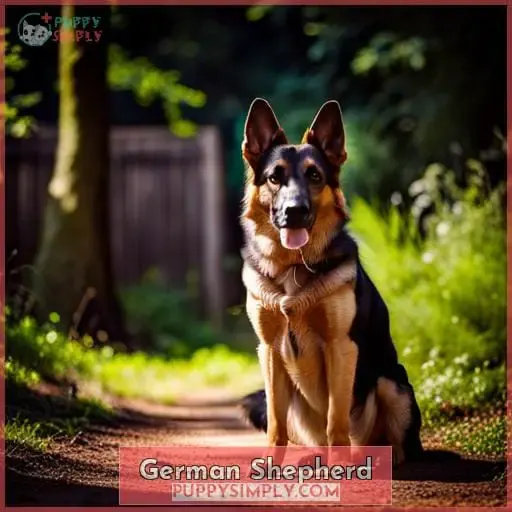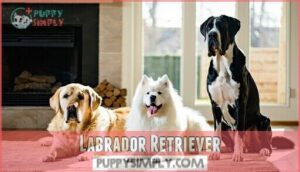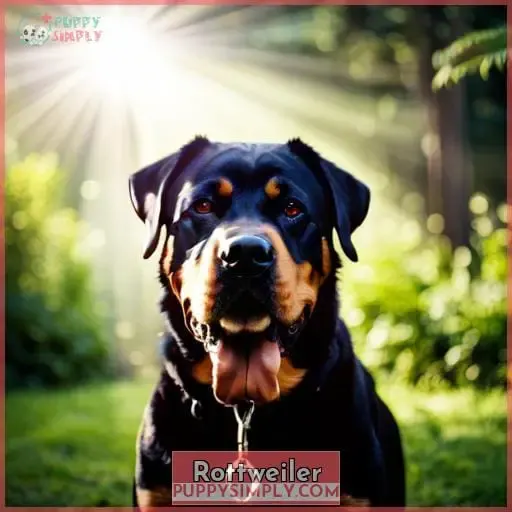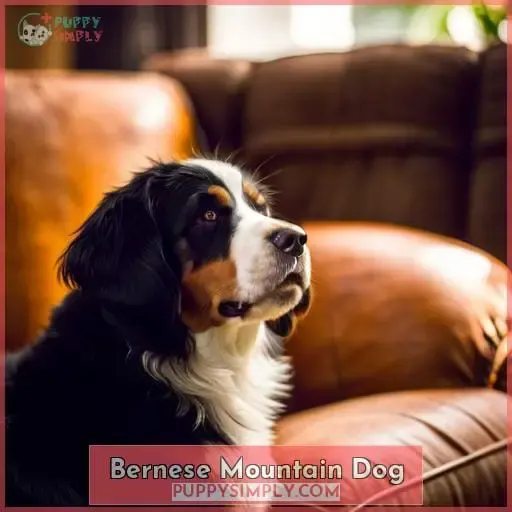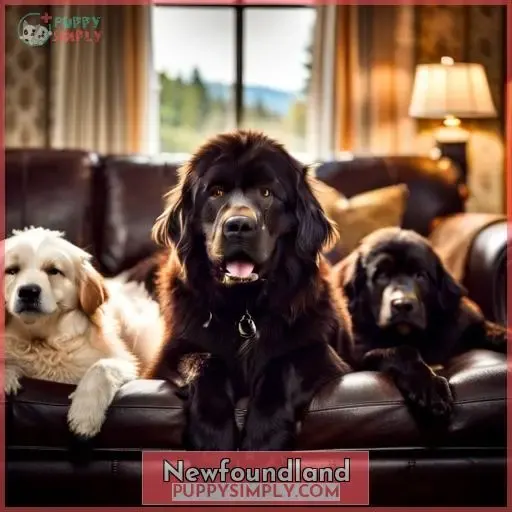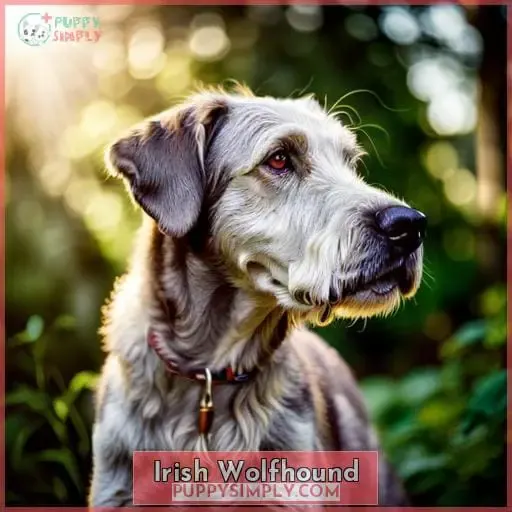This site is supported by our readers. We may earn a commission, at no cost to you, if you purchase through links.
 Imagine coming home to a loyal and loving companion who fills your house with joy. If you’re looking for the perfect large dog breed to make your house feel complete, then look no further. In this article, we will explore three incredible breeds that are not only great for families but also thrive in a household setting: the German Shepherd, Labrador Retriever, and Golden Retriever.
Imagine coming home to a loyal and loving companion who fills your house with joy. If you’re looking for the perfect large dog breed to make your house feel complete, then look no further. In this article, we will explore three incredible breeds that are not only great for families but also thrive in a household setting: the German Shepherd, Labrador Retriever, and Golden Retriever.
Table Of Contents
- Key Takeaways
- German Shepherd
- Labrador Retriever
- Golden Retriever
- Great Dane
- Rottweiler
- Bernese Mountain Dog
- Newfoundland
- Saint Bernard
- Great Pyrenees
- Irish Wolfhound
- Frequently Asked Questions (FAQs)
- Are large dog breeds suitable for small living spaces such as apartments?
- How much exercise do large dog breeds require on a daily basis?
- Are large dog breeds prone to certain health issues?
- Are large dog breeds good with children and other pets?
- What kind of training and socialization do large dog breeds need?
- Conclusion
Key Takeaways
- German Shepherd: Intelligent and trainable breed with strong protective instincts.
- Great Pyrenees: Known as Guardian Giants and Mountain Protectors, excellent with children and other pets.
- Newfoundland: Gentle and patient nature, excellent swimming abilities, and moderate exercise needs.
- Irish Wolfhound: Generally healthy breed, good with children, and doesn’t require excessive exercise.
German Shepherd
The German Shepherd is a large and intelligent breed known for its loyalty, courage, and versatility. They’ve a strong protective instinct which makes them excellent guard dogs, but they also make great family pets with proper training and socialization.
However, it’s important to note that German Shepherds require ample exercise and mental stimulation to prevent boredom or destructive behavior.
Characteristics and Temperament
If you’re considering a German Shepherd as a large dog breed for your house, you’ll be impressed by their remarkable characteristics and temperament.
They’re highly intelligent and trainable dogs, making them excellent working companions.
German Shepherds have moderate energy levels that require regular exercise to keep them physically and mentally stimulated.
When it comes to grooming needs, they’ve a double coat that sheds moderately but requires regular brushing to maintain its health and appearance.
Trainability
- Energy level
- Grooming needs
- Intelligence
- Shedding
Exercise and Training Requirements
Are you wondering how much exercise and training a German Shepherd needs?
German Shepherds are highly active dogs that require daily walks and plenty of mental stimulation to prevent boredom. They also benefit from obedience training, socialization, and puppy classes to ensure they grow up well-rounded and obedient.
Exercise is essential for their physical health, while training provides mental stimulation and helps establish a strong bond between you and your German Shepherd.
Size and Space Considerations
When considering a German Shepherd as a large dog breed for your house, it’s important to take into account the size and space requirements.
German Shepherds are medium to large-sized dogs that require ample space to move around comfortably. They’ve high energy levels and need regular exercise, so having a fenced yard is ideal for them.
Additionally, German Shepherds have moderate shedding potential, which means you should be prepared for some fur maintenance in your home.
Proper crate training, housebreaking, and obedience training are also essential for their overall well-being and behavior management.
Labrador Retriever
When considering a Labrador Retriever as a large dog breed for your house, there are several key points to keep in mind.
First, their temperament and family-friendly nature make them an excellent choice for households with children or other pets.
Second, their exercise needs and activity level require regular physical activity to maintain their overall health and prevent boredom-related behaviors.
Lastly, grooming and shedding considerations should be taken into account as Labradors have a double coat that sheds heavily twice per year.
Temperament and Family-friendly Nature
Now let’s delve into the temperament and family-friendly nature of the Labrador Retriever, continuing our exploration of top large dog breeds for your house.
- The Labrador Retriever is known for its friendly and gentle disposition, making it an excellent choice for families with children.
- They’re highly trainable and obedient dogs, eager to please their owners.
- Early socialization is important to ensure they grow up to be well-mannered around strangers and other animals.
Exercise Needs and Activity Level
To properly care for a Labrador Retriever in your house, it’s important to understand their exercise needs and activity level.
Labrador Retrievers are highly energetic dogs that require daily physical activity to keep them happy and healthy.
Engaging in regular exercise not only helps them burn off excess energy but also provides mental stimulation for this intelligent breed.
Make sure you provide ample opportunities for exercise to meet the Labrador’s need for movement and playtime.
Grooming and Shedding Considerations
To maintain the coat of your Labrador Retriever, regular grooming and shedding management are essential.
Labrador Retrievers have a moderate shedding amount throughout the year, with heavier shedding occurring during seasonal transitions.
They’ve a double-coat consisting of an outer coat and an insulating undercoat, which requires regular brushing to control shedding.
Weekly brushing is recommended to remove loose hair and prevent matting.
Additionally, frequent baths can help keep their coat clean and minimize odors.
Golden Retriever
When it comes to considering a Golden Retriever as a large dog breed for your house, there are several important points to keep in mind.
First and foremost is their temperament and sociability – these dogs are known for their friendly and loving nature, making them excellent companions for families.
Additionally, they’ve high exercise needs and require mental stimulation to thrive, so be prepared to provide ample physical activity and engaging activities.
Lastly, it’s crucial to understand potential health considerations that come with the breed such as hip dysplasia or certain types of cancer that can affect them later in life.
Temperament and Sociability
The Golden Retriever is known for its friendly and sociable nature, making it a popular choice for families looking for a large dog breed.
They’ve high energy levels and love to play, making them great companions for active households.
Their friendliness makes them easy to train and they’re generally good with children and other pets.
In terms of grooming, they do shed quite a bit but regular brushing can help manage their coat.
Exercise and Mental Stimulation Requirements
Meeting the exercise and mental stimulation requirements of a Golden Retriever is essential for their overall well-being and happiness.
These energetic dogs thrive on physical activity and mental challenges.
Engaging in regular exercise, such as brisk walks or runs, playing fetch, or participating in agility training can help keep them physically fit.
Providing mental stimulation activities like puzzle toys, obedience training sessions, or interactive playtime will also help stimulate their intelligent minds and prevent boredom.
Socialization with other dogs and humans is equally important to ensure a well-rounded personality.
Health Considerations and Potential Issues
One important consideration when owning a Golden Retriever is understanding their potential health issues. Like many large dog breeds, Golden Retrievers are prone to certain health conditions such as hip dysplasia, elbow dysplasia, allergies, and cancer.
It’s essential to be aware of these potential problems and take proactive measures to ensure your Golden Retriever stays healthy and receives proper medical care throughout their life. Regular veterinary check-ups and a balanced diet can help mitigate some of these health concerns for your beloved furry friend.
Great Dane
When considering a Great Dane as a potential addition to your household, there are several important points to consider.
First and foremost is their size and space requirements – Great Danes are one of the largest dog breeds, so ample space both indoors and outdoors is necessary for them to thrive comfortably.
Additionally, their temperament makes them excellent companions for families with children, as they tend to be gentle giants who are loving and loyal.
Lastly, it’s crucial to note that Great Danes have high exercise needs and require consistent training in order to ensure they remain well-behaved members of the family.
Size and Space Requirements
When considering the suitability of a Great Dane for your home, it’s important to take into account their size and space requirements.
Great Danes are one of the largest dog breeds and require ample room to move around comfortably.
Space planning is essential when bringing a Great Dane into your household.
They need enough indoor space for daily activities and should also have access to outdoor areas where they can engage in regular exercise.
Adapting your home to accommodate their size is crucial for providing them with a safe and comfortable living environment.
Temperament and Compatibility With Families
Continuing the exploration of large dog breeds for your house, let’s delve into the temperament and compatibility with families of the Great Dane.
Known for their gentle nature and friendly disposition, Great Danes make excellent family pets. They’re affectionate towards children and get along well with other animals in the household.
However, due to their massive size, they may unintentionally knock over small children or fragile items in the house. Proper training and socialization are essential to ensure a harmonious coexistence between this majestic breed and your family members.
Exercise and Training Needs
To properly care for a Great Dane, you must ensure they receive adequate exercise and training.
- Provide daily physical exercise such as long walks or runs.
- Engage in mental stimulation activities like puzzle toys or obedience training.
- Use positive reinforcement techniques for obedience training.
- Be patient with behavioral challenges that may arise due to their size and energy level.
- Consider enrolling them in canine fitness classes to keep them active and socialized.
Rottweiler
The Rottweiler is a large dog breed known for its strong temperament and protective instincts. This breed requires consistent training and socialization from an early age to ensure they become well-behaved companions.
However, it’s important to note that Rottweilers may be prone to certain health concerns and potential genetic issues, so regular vet check-ups are necessary for their overall well-being.
Temperament and Protective Instincts
If you’re considering a Rottweiler as a large dog breed for your home, their temperament and protective instincts make them an excellent choice.
Rottweilers are known to be loyal, confident, and fearless dogs. They have a natural instinct to protect their family members and can be highly territorial. With proper training and socialization from an early age, they can become loving and gentle companions while still maintaining their protective nature.
| Traits | Temperament | Exercise Requirements |
|---|---|---|
| Loyalty | Loyal towards family members | Moderate |
| Confidence | Confident in various situations | |
| Protectiveness Highly Protective of Family |
Training and Socialization Requirements
Now let’s delve into the training and socialization requirements of the Rottweiler, as this breed requires consistent guidance and early exposure to various people, animals, and environments in order to thrive.
Early socialization is crucial for a Rottweiler puppy to develop proper canine communication skills and learn how to interact with different situations. Positive reinforcement methods should be used during their training sessions to address any behavioral challenges that may arise.
Health Concerns and Potential Genetic Issues
The Rottweiler may have certain health concerns and potential genetic issues that you should be aware of before bringing one into your home.
This breed is prone to conditions such as hip dysplasia, which can cause pain and mobility issues.
Other health challenges include heart disease, obesity, and certain types of cancer.
It’s important to practice preventive care by providing a balanced diet, regular exercise, and proper veterinary guidance.
Additionally, responsible breeding practices can help reduce the risk of genetic issues in Rottweilers.
Bernese Mountain Dog
When considering large dog breeds for your house, the Bernese Mountain Dog is an excellent choice due to its gentle nature and friendly temperament.
They’re known for being calm, patient, and great with families and children.
However, it’s important to note that they require regular exercise and grooming maintenance to keep their thick coats healthy.
Additionally, potential owners should be aware of some health considerations such as hip dysplasia which can be common in this breed.
Temperament and Gentle Nature
As we continue our exploration of large dog breeds with gentle temperaments, let’s take a closer look at the Bernese Mountain Dog.
Known for their kind and easygoing nature, these dogs make wonderful companions for families seeking canine companionship.
Training tips include positive reinforcement techniques to harness their intelligence and willingness to please.
Socialization strategies are important from an early age to ensure they interact well with people and other animals.
Health and wellness should be prioritized through regular exercise, proper nutrition, and veterinary care.
Playtime practices should involve activities that stimulate both their minds and bodies, such as interactive toys or agility exercises.
Exercise and Grooming Needs
To properly care for a Bernese Mountain Dog, you need to be aware of its exercise and grooming needs.
-
Exercise Variations:
- Bernese Mountain Dogs require regular physical activity to maintain their health and prevent boredom-related behaviors.
- They thrive with different types of exercises such as daily walks or playtime in a spacious yard where they can run around freely.
-
Grooming Challenges:
- Due the breed’s long and thick double coat, they’ve high grooming needs that shouldn’t be overlooked if you want your dog looking his best all year round!
- Regular brushing is essential at least once or twice per week using an appropriate brush designed specifically for their fur type.
-
Shedding Concerns:
- Keep in mind that this breed sheds heavily during certain seasons like spring when they lose their winter coat; therefore it’s important to invest time regularly into proper maintenance by frequently brushing them out so loose hairs don’t accumulate on furniture surfaces throughout your home!
Remember that every dog has unique exercise requirements depending on age,size,and energy level but it’s crucially important no matter what kind-of-dog-owner-you-are never neglect giving them plenty-of-opportunities-to-exercise-and-play.
With consistency,discipline,and patience,you’ll-be-amazed-at-the-results-you’ll-see-in-your-Bernese-Mountain-Dog’s-happiness-and-overall-well-being.
Health Considerations and Potential Challenges
When considering the health of your Bernese Mountain Dog, it’s important to be aware of potential challenges and take proactive measures to ensure their well-being.
Some common health considerations for this breed include hip dysplasia, elbow dysplasia, and certain types of cancer. Regular exercise is crucial for maintaining their overall health, while proper training can help prevent obesity-related issues.
Additionally, keep in mind any allergy considerations when choosing food or grooming products for your Bernese Mountain Dog.
| Health Challenges | Training Tips | Breed Compatibility |
|---|---|---|
| Hip Dysplasia | Regular exercise | Families with |
| (potential challenge) | – Proper diet | – Children |
| – Socialization | – Other pets |
Exercise Requirements: Moderate to high
Allergy Considerations: May trigger allergies due to shedding
Newfoundland
If you’re looking for a large dog breed with a gentle temperament and suitability as a family pet, the Newfoundland is an excellent choice.
Newfoundlands are known for their loving nature and exceptional patience with small children.
Newfoundlands thrive in families who’ve the space for a 100-pound pooch.
They’re also known for their swimming abilities, making them great companions if you enjoy spending time around water.
In terms of grooming and coat maintenance, Newfoundlands do require regular brushing to keep their thick double coats healthy and free from matting.
Temperament and Suitability as a Family Pet
Does the Newfoundland have a temperament that makes it suitable as a family pet? Absolutely! Here are three reasons why this gentle giant is an excellent choice for families:
- Gentle and patient: Newfoundlands are known for their calm and friendly nature, making them great companions for children.
- Easy to train: Despite their size, Newfoundlands are intelligent and eager to please, making training sessions enjoyable.
- Excellent with other pets: These dogs have a natural affinity for other animals, which means they can easily get along with your existing furry friends.
Overall, the Newfoundland’s temperament makes it an ideal family pet.
Exercise Needs and Swimming Ability
If you’re considering owning a Newfoundland, it’s important to understand their exercise needs and swimming ability.
Newfoundlands are water-loving breeds known for their strength and swimming prowess. They’ve webbed feet and a thick double coat that helps them stay buoyant in the water.
Swimming is an excellent form of exercise for Newfoundlands, as it provides low-impact cardio workout and engages multiple muscle groups. Additionally, aquatic canine fitness activities like hydrotherapy can provide numerous benefits for these gentle giants’ overall health and well-being.
Grooming and Coat Maintenance
To maintain the Newfoundland’s beautiful coat, you’ll need to regularly groom and provide proper coat maintenance.
Here are some grooming tips for your Newfoundland:
- Brushing Techniques:
- Use a slicker brush or a wide-toothed comb to remove any tangles or mats in their dense double coat.
- Shedding Solutions:
- Newfoundlands are heavy shedders, so regular brushing can help minimize shedding and keep their fur under control.
- Coat Care Essentials:
- Invest in good quality grooming tools like deshedding tools and detangling sprays to keep your Newfoundland’s coat healthy and shiny.
By following these tips, you can ensure that your Newfoundland looks fabulous while keeping their fur well-maintained!
Saint Bernard
Moving on from discussing the Newfoundland, another majestic and beloved large breed is the Saint Bernard.
These gentle giants are often associated with images of snowy mountains and rescue missions in ski resorts. With their thick winter woollies, these dogs are well-suited for alpine adventures and harsh weather conditions.
Saint Bernards have a long history as barrel rescues, where they’d carry small barrels filled with brandy to revive stranded travelers in the Swiss Alps. Their calm temperament makes them wonderful family pets despite their size, earning them a reputation as gentle giants.
While they may not be as active or energetic as breeds like German Shepherds or Labrador Retrievers, regular exercise is still important to keep them healthy and maintain an appropriate weight due to their massive frames.
If you’re looking for a loyal companion that embodies both strength and kindness, consider adding a Saint Bernard to your household.
Great Pyrenees
As we move on to the next large dog breed, let’s talk about the Great Pyrenees, a majestic and gentle giant.
Known as one of the Guardian Giants and Mountain Protectors, these dogs possess an impressive presence that can make anyone feel safe and secure.
With their Pyrenean Majesty, they’ve long been valued for their ability to guard livestock against predators in mountainous regions.
Originating from France, this breed has a rich Herding Heritage which contributes to their natural instincts for protecting those around them.
Despite their size and strength, Great Pyrenees are known for being incredibly gentle with children and other pets.
They require moderate exercise but excel at lounging around with you in your home due to their calm nature.
If you’re looking for a loyal companion who embodies both power and gentleness, then consider welcoming a Great Pyrenees into your family.
Irish Wolfhound
Continuing on from the previous discussion, if you’re looking for a large dog breed that combines size and gentleness, consider the Irish Wolfhound.
-
Ancient Origins:
- The Irish Wolfhound has a rich history dating back thousands of years in Ireland.
- They were originally bred as hunting dogs for wolves and other large game.
-
Health Considerations:
- Despite their impressive stature, Irish Wolfhounds are generally healthy dogs with few genetic health issues compared to other large breeds.
- However, they may be prone to certain conditions like bloat and heart disease.
-
Irish Wolfhound Myths:
- Contrary to popular belief, these gentle giants don’t require excessive exercise due to their calm nature.
- Additionally, they’re known for being good with children and making excellent family pets.
4.Size and Gentle Nature:
- Standing at an average height of 32-34 inches at the shoulder and weighing between 120-180 pounds (male) or 100-150 pounds (female), the Irish Wolfhound is one of the tallest dog breeds in existence while also possessing a sweet disposition.
When it comes to caring for an Irish Wolfhound, regular exercise tailored to their needs along with proper nutrition will ensure they remain happy and healthy companions.
Frequently Asked Questions (FAQs)
Are large dog breeds suitable for small living spaces such as apartments?
Large dog breeds are generally not suitable for small living spaces such as apartments.
They require ample room to move around and exercise, which may be limited in confined areas.
Smaller breeds are better suited for apartment living.
How much exercise do large dog breeds require on a daily basis?
Looking for large dog breeds suitable for your house?
How much exercise do they need?
Well, these big pups thrive with regular physical activity. Daily walks and playtime will keep them happy, healthy, and content in your home.
Are large dog breeds prone to certain health issues?
Large dog breeds, like German Shepherds, Great Danes, and Bernese Mountain Dogs, can be prone to certain health issues such as hip dysplasia and bloat. Regular veterinary check-ups and proper care can help mitigate these risks for a healthier pet.
Are large dog breeds good with children and other pets?
Large dog breeds, such as the Labrador Retriever, Golden Retriever, and Irish Setter, are known to be great with children and other pets. In fact, studies show that these breeds have a high compatibility rate for family households.
What kind of training and socialization do large dog breeds need?
Large dog breeds, such as German Shepherds, Great Danes, and Golden Retrievers, benefit from early socialization and obedience training.
This helps them develop good manners and ensures they can interact safely with children and other pets in your household.
Conclusion
To find the perfect large dog breed for your home, consider the German Shepherd, Labrador Retriever, or Golden Retriever. These breeds offer a combination of loyalty, family-friendliness, and adaptability to a household setting.
Each breed has unique characteristics, exercise requirements, and grooming needs, so it’s important to choose the one that best suits your lifestyle and living space.
Whether you prefer the German Shepherd’s intelligence, the Labrador Retriever’s friendly nature, or the Golden Retriever’s sociability, any of these breeds will bring joy and companionship to your home.

